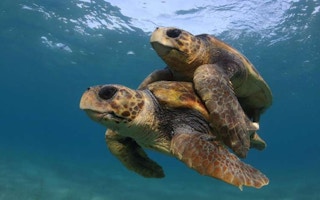Climate change could cast a dark shadow over the bees of Europe, with global warming posing sex problems for the sea turtles of the Atlantic.
Two separate studies confirm the worries that rising carbon dioxide levels, and soaring planetary temperatures, could devastate the creatures of the wild.
There are an estimated 550 species of bee in Germany, many of them solitary and short-lived: Females devote their few weeks in the sun to feeding, reproducing and leaving food for their offspring.
What becomes of vital importance is the moment of hatching: If a bee emerges from hibernation too early, there is no food available, and starvation can follow. And spring has advanced steadily through the decades.
“
Temperatures are too high and the developing embryos do not survive. This threatens the long-term survival of this sea turtle population.
Jacques-Olivier Laloë, University of Würzburg
Controlled environment
Researchers at the University of Würzburg report in the Journal of Animal Ecology that they set up 36 large flight cages to experiment with three species of mason bee that emerge in the spring, and controlled the cage environment so that the bees emerged as the plants in the cage flowered, or three, or six days previously.
Then they monitored the bees over the brief bee lifespan. Some of the bees that emerged too early did not survive. Those that did survive were less active and produced fewer of the next generation.
“Already, a minor temporal mismatch of three or six days is enough to harm bees,” said Mariela Schenk, who led the study.
One species responded to the food shortage by producing fewer females and more males – drones need less food than females. Another species responded by placing fewer brood cells in each nest. A third species became more active in the second half of its life, but not active enough to offset the bad start.
Overall, bad timing seemed to be bad for the bees. The plants that depend on bee pollination can hardly profit either.
Creatures of habit
Research like this now confirms that climate change is going to impose a toll on biodiversity: Like humans, wild things like the weather patterns to be more or less predictable.
There is clear and repeated evidence that alpine insects, plants and even birds need to move to higher ground as temperatures rise. Butterflies, too, face the same challenge and ecologists and biologists have begun to record local extinctions: even if the species survives, its range becomes more limited.
The loggerhead sea turtle could be at risk for a different reason: It is one of those species in which the sex of the hatchling is determined by the temperature at which it incubates.
Scientists from Swansea University in the UK report in the journal Global Change Biology that they monitored sand temperatures at a loggerhead turtle nesting site at Cape Verde in the tropical Atlantic for six years.
They also recorded the survival rates of 3,000 nests to find a link between incubation temperature and hatchling survival, and then they simulated the challenge for the species as planetary temperatures climb over the rest of the century.
For the moment, the turtles are safe. Warmer incubation will for a while increase the natural growth rate of a population. Warmer temperatures mean more females and more hatchlings.
“However, beyond a critical temperature, the natural growth rate of the population decreases because of an increase of temperature-linked in-nest mortality. Temperatures are too high and the developing embryos do not survive. This threatens the long-term survival of this sea turtle population,” said Jacques-Olivier Laloë, who led the research.
“In recent years, in places like Florida – another important sea turtle nesting site – more and more turtle nests are reported to have lower survival rates than in the past.”
“This shows that we should really keep a close eye on incubation temperatures and the in-nest survival rates of sea turtles if we want to successfully protect them.”
This story was published with permission from Climate News Network.










